Disclaimer: None of the opinions I express about Tibet and my experience is due to my guide or his agency. I formed these opinions on my own, and they should not be attributed to anybody else.
We woke up in plenty of time to get to the airport for our flight to Tibet. Four became three as S was flying on to Japan so we said our farewells. Once the security agent realized that we were going to Tibet, they pulled us out of the queue and escorted us to a "special" security area where the check was extra tight. We cleared security without any problems, and we arrived in Lhasa airport after a quick stop in Chengdu. Lhasa is at 3,570 meters (11,710 ft), and I immediately felt the change in altitude - my fingers and toes started to tingle uncomfortably and would continue to do so for the next three days.
Our guide, Tse, greeted us with white scarves that he placed around our necks. He explained that in Tibetan culture, people exchange white tokens when they first meet someone to show that they come with a pure heart. Why did we have a guide? We didn't have a choice. China requires non-Chinese foreigners to have a guide the entire time we're in Tibet, and we also needed permits for every part of the country we visited on top of the Tibeant permit we had to obtain before we could even buy a plane ticket to Lhasa.
It was an hour's drive before we arrived in Lhasa and were dropped off at our hotel, Shambala Palace, which strangely enough is owned by a former New York lawyer. The hotel is located in the preserved Tibetan Quarter, and the area was a bit of a maze made more confusing by the fact that everything kind of looks alike.
The hotel had some interesting touches:
The door to our room...
Prayer beads hanging about...
Our stone bathroom...
Yak curtain around the bed... hm, never seen that before...
But the best part was the view from the rooftop...
We had a chance to settle in before our guide's partner, Dhon, picked us up to take us out to dinner at a shoe store/restaurant. Buy shoes outside and then come in for a bowl of nice yak noodle soup! We didn't buy any shoes, but we did have yak noodle soup along with some sweet tea, which is a black tea mixed with yak milk and sugar. If you couldn't tell already, the yak is a pretty important animal to Tibetans, especially in their cuisine. The yak turned out to be really flavourful, and we had no problems finishing our noodles.
We returned to the hotel for a good night's sleep, but the combination of altitude and the freezing cold made that pretty impossible. Our hotel room turned out to be long on charm but short on heat - the teeny tiny heater turned out to be pretty useless.
We started out the next morning with a simple breakfast of yak yoghurt with muesli and honey, some fried eggs and toast smeared with yak butter, and I washed it all down with coffee with a bit of yak milk. The yoghurt was light and a bit tart, and the yak butter was slightly sweet and much tastier than cow butter.
Breakfast was followed by a short walk to the nearby Jokhang Monastery.
The first thing I noticed were the pilgrims prostrating themselves outside of the monastery.
Some of the pilgrims had mats and others wore tough aprons with wooden panels attached to their hands. They were of all ages, in many different forms of dress, but they were all prostrating themselves repeatedly in front of the monastery.
Other pilgrims walked in a clockwise circuit around the temple. Some were also prostrating, but many were just walking with prayer wheels or prayer beads in hand.
There was also a massive queue of pilgrims waiting to go in to be blessed by one of the oldest Buddha statues ever. As tourists, we were permitted to bypass the queue and once inside, we saw the famous yak butter lamps that illuminated the temple. The pilgrims had jugs in hand that were filled with vegetable oil to add fuel to the flames. The pilgrims that weren't filling the lamps were placing money on every available surface or waiting patiently to touch their head to the Buddha's knee.
We wended our way up around the monastery and headed to the roof for magnificent views of the city, including Barkhor Square right next door and the Potala Palace in the distance.
We woke up in plenty of time to get to the airport for our flight to Tibet. Four became three as S was flying on to Japan so we said our farewells. Once the security agent realized that we were going to Tibet, they pulled us out of the queue and escorted us to a "special" security area where the check was extra tight. We cleared security without any problems, and we arrived in Lhasa airport after a quick stop in Chengdu. Lhasa is at 3,570 meters (11,710 ft), and I immediately felt the change in altitude - my fingers and toes started to tingle uncomfortably and would continue to do so for the next three days.
Our guide, Tse, greeted us with white scarves that he placed around our necks. He explained that in Tibetan culture, people exchange white tokens when they first meet someone to show that they come with a pure heart. Why did we have a guide? We didn't have a choice. China requires non-Chinese foreigners to have a guide the entire time we're in Tibet, and we also needed permits for every part of the country we visited on top of the Tibeant permit we had to obtain before we could even buy a plane ticket to Lhasa.
It was an hour's drive before we arrived in Lhasa and were dropped off at our hotel, Shambala Palace, which strangely enough is owned by a former New York lawyer. The hotel is located in the preserved Tibetan Quarter, and the area was a bit of a maze made more confusing by the fact that everything kind of looks alike.
The hotel had some interesting touches:
The door to our room...
Prayer beads hanging about...
Our stone bathroom...
Yak curtain around the bed... hm, never seen that before...
But the best part was the view from the rooftop...
We had a chance to settle in before our guide's partner, Dhon, picked us up to take us out to dinner at a shoe store/restaurant. Buy shoes outside and then come in for a bowl of nice yak noodle soup! We didn't buy any shoes, but we did have yak noodle soup along with some sweet tea, which is a black tea mixed with yak milk and sugar. If you couldn't tell already, the yak is a pretty important animal to Tibetans, especially in their cuisine. The yak turned out to be really flavourful, and we had no problems finishing our noodles.
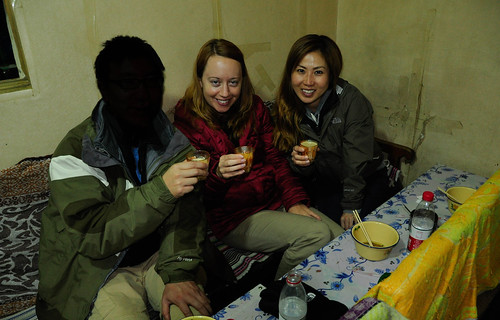 |
| No, I didn't dine with demons - he doesn't know I keep this blog, and I'd like to respect his privacy. |
We started out the next morning with a simple breakfast of yak yoghurt with muesli and honey, some fried eggs and toast smeared with yak butter, and I washed it all down with coffee with a bit of yak milk. The yoghurt was light and a bit tart, and the yak butter was slightly sweet and much tastier than cow butter.
Breakfast was followed by a short walk to the nearby Jokhang Monastery.
The first thing I noticed were the pilgrims prostrating themselves outside of the monastery.
Some of the pilgrims had mats and others wore tough aprons with wooden panels attached to their hands. They were of all ages, in many different forms of dress, but they were all prostrating themselves repeatedly in front of the monastery.
Other pilgrims walked in a clockwise circuit around the temple. Some were also prostrating, but many were just walking with prayer wheels or prayer beads in hand.
There was also a massive queue of pilgrims waiting to go in to be blessed by one of the oldest Buddha statues ever. As tourists, we were permitted to bypass the queue and once inside, we saw the famous yak butter lamps that illuminated the temple. The pilgrims had jugs in hand that were filled with vegetable oil to add fuel to the flames. The pilgrims that weren't filling the lamps were placing money on every available surface or waiting patiently to touch their head to the Buddha's knee.
We wended our way up around the monastery and headed to the roof for magnificent views of the city, including Barkhor Square right next door and the Potala Palace in the distance.
Later that day, we visited Sera Monastery to see the famous debating monks.
The monks pair up, and one acts as the questioner (standing up) while the other responds (sitting down). They can debate on the same topic for 2-3 hours, and the questioner has a range of motions that he displays to the answerer. The most common movement is raising your arm with the elbow bent to symbolize the sword of wisdom. Slapping the arm down against an open palm symbolizes the sword cutting through ignorance.
We headed back to the car after watching the monks for a while, and we came upon an unexpected treat. I heard singing voices, and I followed the sound until I reached a group of labourers working on top of a roof in the traditional Tibetan way.

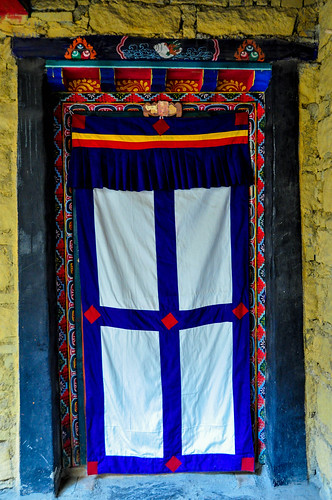
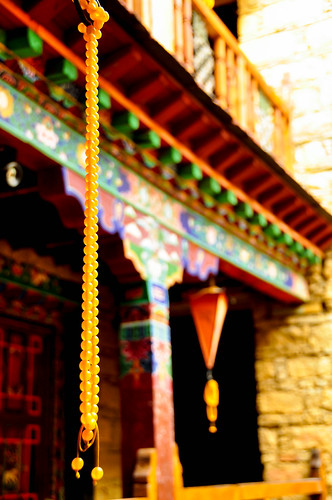

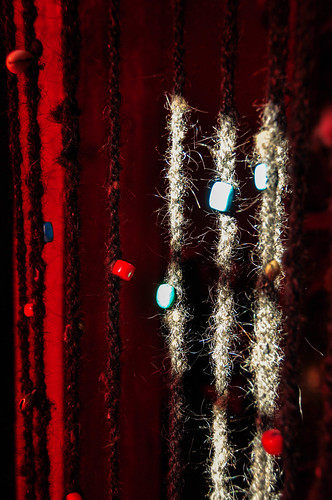
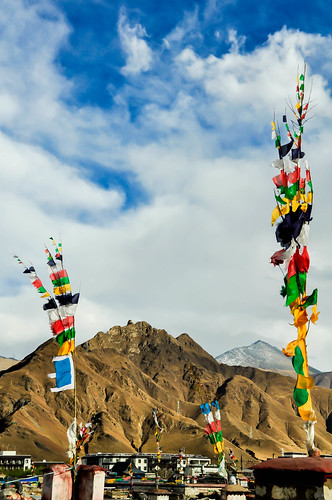
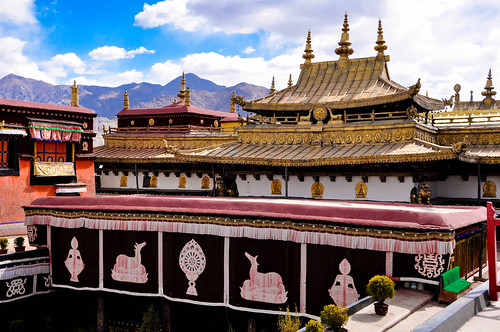

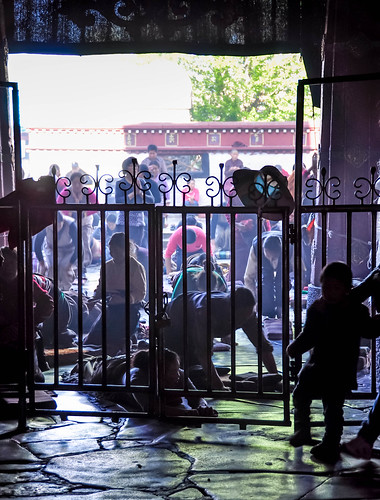
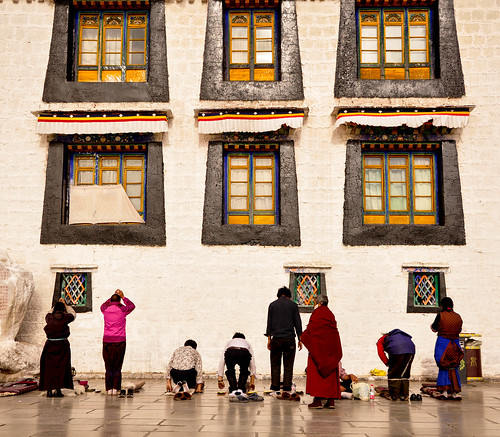
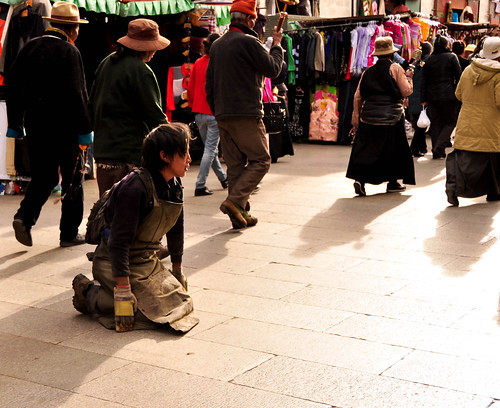
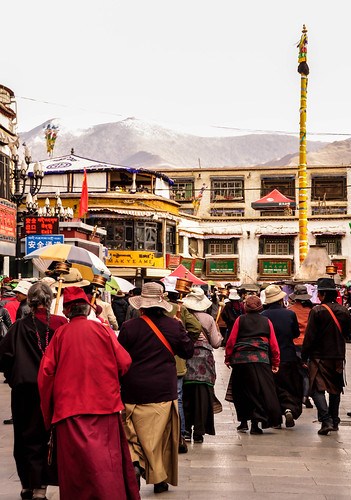

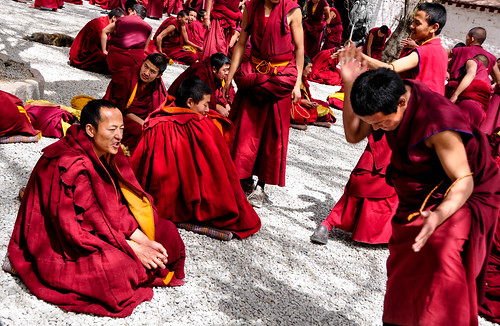

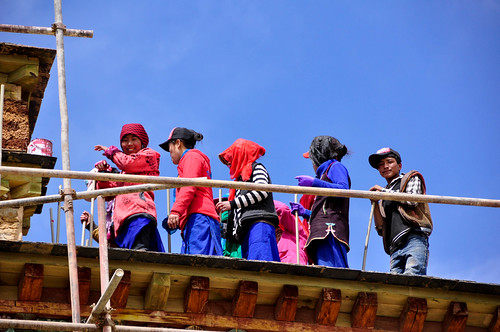
I love Tibet. My brother worked in China for 6 years and he had incredible (scary and beautiful) stories to share from the two trips he took there. However, he never mentioned a guide (which he mentioned from other trips he had done). I wonder if that is a new thing since the Uighur/uyghur "uprising"?
ReplyDeleteHi Worthington! I think a guide isn't required in some eastern parts of Tibet but is now required for where we wanted to go, namely Lhasa and Everest base camp. It was such a beautiful country, and the people were wonderful. I hope your brother enjoyed China more than I did! =)
DeleteThis comment has been removed by the author.
ReplyDelete